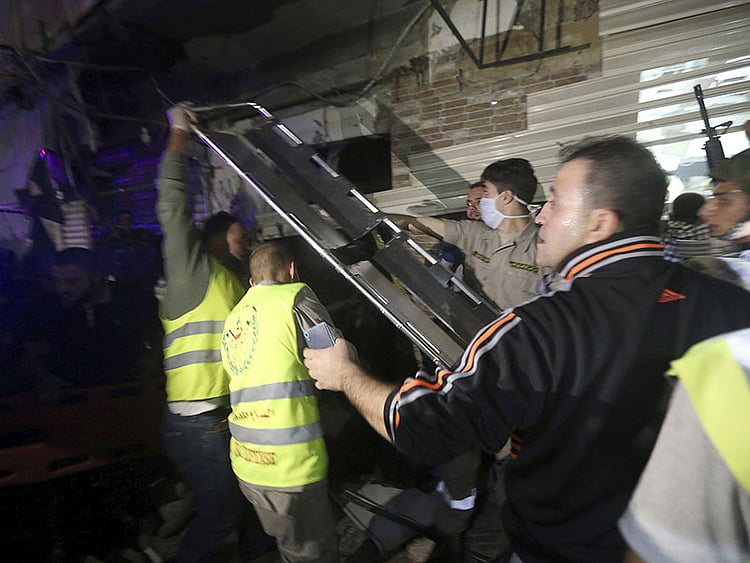Beirut: Two “Abu Musabs” are already heavily entrenched in the history of Al Qaida, one Syrian (Abu Musab Al Souri) and one Jordanian (Abu Musab Al Zarqawi) — both early associates of Osama Bin Laden.
A third has now seemingly emerged from the Daesh "capital" of Al Raqqa, and is threatening to bring the terrorist organisation into the heart of Lebanon.
Daesh claimed responsibility for the terrorist attack in the Beirut suburb of Burj Al Barajneh on Thursday, killing at least 44 people and wounding 200.
This was the deadliest attack in Lebanon since the twin attacks on the Iranian Embassy in Beirut back in November 2013.
Last February, Lebanese authorities confirmed that 700 Lebanese citizens had joined Daesh and were building up on the Syrian side of the border, preparing to invade Lebanon.
Days later a photo went viral from the Rumeih prison outside Beirut, showing extremist inmates with a Daesh flag hanging from a bookshelf behind them, prompting Prime Minister Tammam Salam to comment that Daesh was “alive” in Lebanon.
One month later, a military court issued verdicts against 17 Lebanese citizens for membership in the terror group. Six were apprehended and eleven are on the loose — perhaps explaining how Daesh penetrated the Hezbollah stronghold of Burj Al Barajneh on Thursday.
Unlike the case in Syria, where most of its members are Iraqis, North Africans or Asians, Daesh in Lebanon is almost exclusively an all-Lebanese organisation.
'Abu Musab Halous'
Its members lead normal lives during the day, going wherever they please with valid Lebanese identity documents. These men are the crux of the so-called “Lebanon Emirate” of Daesh, run by Khalaf Zeyabi Halous, also known as Abu Musab Halous.
He is, however, a Syrian.
A 35-year old shepherd from the village of Sallouk in Syria, who joined the “Sunni insurgency” in Iraq back in 2003, Halous was heavily inspired by his compatriot and namesake, Abu Musab Al Souri, an early associate of Bin Laden.
In 2004 Halous pledged allegiance to Al Qaida in Iraq, headed by his other namesake, Abu Musab Al Zarqawi.
When US air strikes intensified after Zarqawi’s killing in 2006, Halous left Iraq and returned briefly to his native Syria, then went to Qatar where he worked as a cement truck driver until the outbreak of the Syrian uprising in 2011.
He returned to Syria and joined Jabhat Al Nusra, helping the Syrian branch of Al Qaida overrun his native Al Raqqa in 2013. His family home in the countryside of Al Raqqa was donated to Jabhat Al Nusra to run administrative affairs during their short rule of the province.
When Daesh stormed the city in August 2014, Halous automatically pledged loyalty to its self-proclaimed caliph, Abu Bakr Al Baghdadi.
'Vicious governor'
Halous is no joke; he is a vicious militant with a track record of kidnapping, assassination, and corruption.
His appointment in Lebanon falls in line with Al Baghdadi’s policy of never allowing Daesh ‘governors’ to reside in provinces they rule.
The “emir” of Al Raqqa, for example, lives in Mosul while the Daesh ‘governor’ of Al Bab near Aleppo resides in Deir Al Zour along the Euphrates River. The “emir” of Lebanon lives in Al Raqqa where he coordinates work with other Daesh branches in Gaza, Sinai, and Libya.
In some of its beheading videos, Daesh figures have threatened to re-conquer Spain and reach as far as Rome. Beirut — of course — is much closer geographically and easier for Daesh, as is clear from Thursday’s bombings.
Daesh attacks in Lebanon have mostly been launched against Hezbullah strongholds, from the outskirts of the north-eastern town of Arsal in the Baalbek region. It managed to recruit fighters from Fateh Al Islam, a terrorist group that thrived in Lebanon’s Palestinian refugee camps for an entire decade.
The main magnet was at Ain Al Hilweh, a condensed and poor camp southeast of the port city of Sidon, packed with impoverished families, clustered mosques, powerful clerics — and heavily armed young men armed.
The Al Qaida cell at Ain Al Hilweh has 150 members, commanded by three Palestinians. The second cell is situated in the northern Lebanese city of Tripoli, with 400 fighters, while smaller ones are dotted across the Lebanese Bekaa Valley.
Sign up for the Daily Briefing
Get the latest news and updates straight to your inbox
Network Links
GN StoreDownload our app
© Al Nisr Publishing LLC 2025. All rights reserved.
